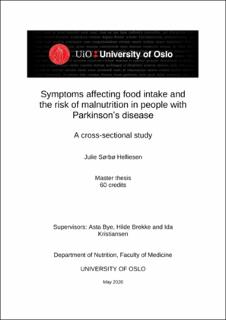| dc.description.abstract | Background: People with Parkinson’s disease (PD) often experience symptoms that affect their ability to eat as well as cardinal symptoms that increase energy expenditure (rigidity, tremor, bradykinesia). These symptoms may contribute to weight loss and increased risk of malnutrition. Objectives: The aim of this cross-sectional study was to investigate the prevalence of malnutrition risk, malnutrition and nutrition impact symptoms, like dysphagia among people with PD, who are patient members of the Norwegian Parkinson’s association. Methods: All registered patient members at the Norwegian Parkinson's Association were invited to respond to an online 24-item questionnaire via their registered email address. Background questions, as well as questions from two validated questionnaires were adapted to an online format (Nettskjema). The abridged patient-generated subjective global assessment (aPG-SGA) was used to measure nutritional status and The Radboud Oral Motor Inventory for Parkinson's disease (ROMP) was used to measure dysphagia. Results: The questionnaire was sent to 3047 registered members, of which 508 persons (17%) responded within the deadline (61% men). Of these, 59% were categorized as well-nourished (aPG-SGA A), 34% at risk of malnutrition (aPG-SGA B) and 6.5% as malnourished (aPG-SGA C). Malnourished participants had more swallowing problems than well-nourished, respectively, a mean total ROMP score of 15.5 (6.0) versus 9.0 (2.9). About half of all participants had difficulty swallowing solids, as well as concerns about these complaints. By adjusting for age and PD duration, the ROMP score was significantly associated with aPG-SGA score. A quarter of all participants reported symptoms that affected food intake, and the most frequently reported symptom being constipation (14.2%) and dry mouth (13.4%). On average, 3.4 (1.4) symptoms per malnourished participant were reported, as opposed to 0.1 (0.3) symptoms per well-nourished participant. Conclusion: Risk of malnutrition seems to be relatively common in people with PD. The prevalence was largely related to a number of self-reported symptoms, especially dysphagia. Symptoms affecting food intake should be systematically mapped in conjunction with PD to prevent malnutrition. Future research investigating the relationship between PD, malnutrition and dysphagia is needed. | en_US |
